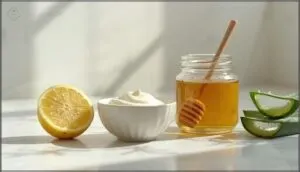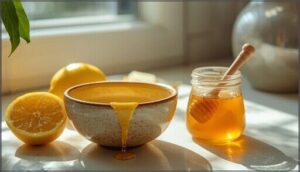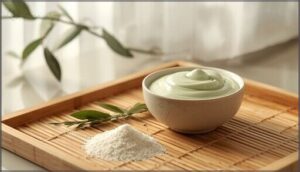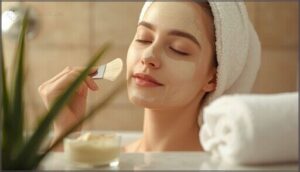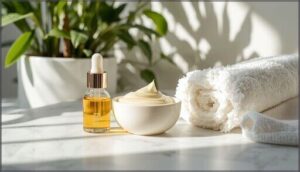This site is supported by our readers. We may earn a commission, at no cost to you, if you purchase through links.
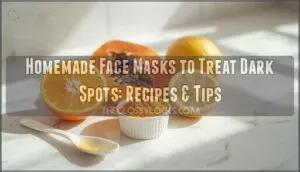
Overpriced creams promise the moon, but your kitchen packs quiet ingredients with a proven punch—lemons, turmeric, even papaya. Homemade face masks to treat dark spots aren’t magic, but they’re backed by solid science and centuries of tradition.
Curious how simple recipes can refresh your skin’s canvas? Grab a spoon.
Table Of Contents
- Key Takeaways
- Benefits of Homemade Face Masks for Dark Spots
- Key Ingredients for Dark Spot-Targeting Face Masks
- DIY Face Mask Recipes for Treating Dark Spots
- Application Techniques for Homemade Dark Spot Masks
- Enhancing Results of Dark Spot Face Masks
- Frequently Asked Questions (FAQs)
- What are the best DIY face masks for dark spots?
- What are the home remedies to remove dark spots on the face?
- How long does it take to see results?
- Can I use homemade masks with other skincare products?
- Are there potential side effects of DIY masks?
- How often should I apply homemade dark spot masks?
- Can these masks be used on sensitive skin?
- Are homemade face masks safe during pregnancy?
- Can I store leftover homemade face mask mixtures?
- What are common allergic reactions to natural masks?
- Conclusion
Key Takeaways
- Homemade face masks can safely fade dark spots using natural ingredients like turmeric, lemon, and papaya that have proven skin-brightening effects.
- Regular use of gentle exfoliants and vitamin-rich foods helps remove dark patches while being easy on your wallet and customizable to your skin type.
- Applying masks with proper skin prep and targeted techniques boosts results, but consistency and sun protection matter most for lasting improvements.
- Always patch test DIY masks, watch for irritation, and remember that gradual change is normal when treating stubborn spots at home.
Benefits of Homemade Face Masks for Dark Spots
Homemade face masks offer real solutions for fading dark spots without harsh chemicals or expensive treatments. They combine natural brightening ingredients with gentle care that respects your skin’s needs.
Homemade face masks gently fade dark spots using natural ingredients, offering an effective and chemical-free solution for healthier skin
Let’s explore the key benefits that make DIY masks worth adding to your routine.
Natural Skin Brightening Properties
When you tap into the power of homemade face masks, you’re accessing genuine natural skin brightening properties backed by science. Clinical studies show that natural ingredients can deliver measurable melanin regulation—turmeric reduces pigment formation by 36%, while vitamin C from citrus inhibits melanin oxidation by about 25%.
These DIY remedies work through multiple pathways:
- Antioxidant effects that fight free radicals and protect your skin from oxidative stress
- Herbal efficacy through compounds like glabridin from licorice, which rivals prescription treatments
- Transport inhibition that blocks melanin from settling into your skin cells
- Tyrosinase blocking that stops dark spots at their source
You’re not just slapping ingredients on your face—you’re using nature’s chemistry to fade hyperpigmentation safely and effectively. Many botanical extracts can serve as alternative depigmenting products.
Gentle Exfoliation for Hyperpigmentation
Gentle exfoliation works like a reset button for skin struggling with dark spots. When you use homemade face masks with natural exfoliants, you’re removing pigmented dead cells that make hyperpigmentation look worse. Clinical studies show that alpha-hydroxy acids and fruit enzymes in DIY masks can brighten dark spots after four to six weeks of consistent use—slower than prescription peels but much safer for ongoing treatment. A common cause is excess melanin production, which exfoliation can help to reduce.
Here’s what gentle exfoliation does for you:
- Speeds up cell turnover so fresh, brighter skin surfaces faster
- Helps lightening ingredients penetrate deeper where they’re needed most
- Prevents buildup that makes spots look darker and more stubborn
- Improves texture so your whole complexion looks more even
The key is staying gentle. Oatmeal, honey, and papaya enzymes offer exfoliation safety without the irritation risk of harsh scrubs. Use your mask twice weekly and you’ll maintain steady progress without disrupting your skin barrier.
Cost-Effective Alternative to Commercial Products
Making your own face masks isn’t just smart for your skin—it’s outstanding for your budget. Here’s the real deal on ingredient affordability: you’ll spend $0.50 to $1.50 per application instead of $8 to $68 for branded masks. That’s market expenditure you control! DIY face mask recipes using natural ingredients like honey and oatmeal create cost-effective treatments while supporting waste reduction and personalization trends. When treating dark spots, homemade face masks deliver impressive cost-benefit without the markup.
| Commercial Products | Homemade Alternatives |
|---|---|
| $60–$120 monthly | Under $10 monthly |
| 58% contain synthetics | 100% ingredient control |
| Single-use packaging | Reusable containers |
| $8–$68 per mask | $0.50–$1.50 per mask |
| Fixed formulations | Fully customizable |
Customizable Ingredients for Specific Skin Types
Beyond budget savings, homemade face masks give you complete control over what touches your skin. Think of it as individual skincare—no guesswork, just ingredients matched to your needs. Sensitive skin benefits from colloidal oatmeal and chamomile, which lower skin irritation by 60% compared to synthetic formulations.
Here’s how to customize your dark spot treatment:
- Dry skin: Avocado, yogurt, and honey for deep hydration
- Oily skin: Coconut-based masks to balance oil production
- Aging skin: Baobab oil for fine lines and age spots
- Combination skin: Hyaluronic acid with aloe vera gel
- Sensitive skin: Shea butter and calendula oil for barrier repair
You control every ingredient, avoiding irritants while targeting hyperpigmentation effectively.
Convenient Integration Into Skincare Routines
Mornings or evenings, you can slide homemade face masks for dark spots right into your usual skincare routine without a hitch. Thanks to ingredient accessibility and customizable ingredients, whipping up a treatment is as easy as raiding your kitchen.
Whether you’re a weekly masker or prefer multi-masking, routine time efficiency means you never have to choose between results and convenience.
Sustainable skincare isn’t just a buzzword—it’s your new normal, all from the comfort of your own bathroom.
Key Ingredients for Dark Spot-Targeting Face Masks
It all starts with the right ingredients. Some natural options pack a real punch against dark spots and stubborn discoloration.
Here’s what you’ll want to look for if you’re building your own face mask.
Vitamin C-Rich Sources (Lemon, Orange, Papaya)
Have you ever thought about how a slice of lemon or juicy papaya could change your skin game? Vitamin C-rich fruits—like lemon, orange, and papaya—are the superheroes in homemade face masks for fading dark spots fast. When you use the right concentration, these DIY face mask recipes deliver serious skin-brightening power.
Papaya enzymes gently sweep away dullness, while orange benefits leave your skin glowing. Lemon can work wonders but—watch out for photosensitivity, so use it wisely. These ingredients do the heavy lifting:
- Boost collagen for firmer skin
- Fade stubborn dark spots
- Fight sun-related damage
- Lightly exfoliate and renew
- Support an all-day radiant glow
Tyrosinase Inhibitors (Turmeric, Licorice Root)
When battling stubborn dark spots, think of turmeric and licorice root as your skin-brightening ace team. Turmeric benefits go beyond cooking—it soothes, brightens, and reduces hyperpigmentation by blocking tyrosinase. Licorice efficacy shines too, thanks to its gentle inhibitor mechanisms.
Combine them in a Licorice Root Brightening Face Mask for serious glow. Just don’t overdo it—these tyrosinase inhibitors work best with thoughtful, consistent use.
| Ingredient | Action on Skin | Safety Considerations |
|---|---|---|
| Turmeric | Brightens, soothes | Possible staining |
| Licorice Root | Eases dark spots | Rare irritation |
| Combo Mask | Blocks pigmentation | Patch test first |
Natural Exfoliants (Honey, Brown Sugar, Oatmeal)
Ever wish you could sweep away dull, stubborn dark spots without harsh chemicals? Natural exfoliants are your skin’s best teammates. With honey benefits for healing, sugar exfoliation to smooth, and oatmeal masks for a gentle scrubbing touch, these DIY recipes make homemade face masks a joy.
- Honey hydrates and soothes
- Sugar buffs away dead skin
- Oatmeal calms irritation
- Gentle scrubbing boosts radiance
- DIY recipes put you in control
Why not treat your skin to something naturally sweet?
Skin-Lightening Agents (Aloe Vera, Yogurt, Milk)
Think your fridge can’t help fade dark spots? Think again. Aloe vera glides on quick, cools oily skin, and shows real melanin suppression. Yogurt benefits come from lactic acid, gently brightening and softening. Milk applications, beloved for generations, offer clothed-in-velvet exfoliation. These homemade face masks bring skin-lightening punch with gentle, proven ingredients.
Here’s a quick at-a-glance guide:
| Ingredient | How It Helps | Best For |
|---|---|---|
| Aloe Vera | Melanin suppression | Oily/sensitive skin |
| Yogurt | Lactic acid, brightens | Uneven or dull tone |
| Milk | Soft exfoliation | Dry, spot-prone skin |
Antioxidant-Rich Components (Green Tea, Berries)
Want a glow with backup? Green tea and berries deliver more than a tasty snack—they load skin with antioxidants proven for free radical scavenging and polyphenol benefits. Expect brighter skin and UV protection that reinforces your natural barrier.
- Gentle vitamin C boost
- Daily inflammation reduction
- Polyphenols for true skin brightening
- Strengthened skin barrier support
- Even protection after sun exposure
Who knew your tea time could treat your glow so well?
DIY Face Mask Recipes for Treating Dark Spots
Ready to give your skin some extra care at home? Here are a few face mask recipes that use easy-to-find ingredients and target stubborn dark spots. Take a look and see which one fits your routine best.
Lemon and Honey Brightening Mask
With homemade face masks, the lemonhoney brightening mask really shines for those stubborn dark spots. Lemon, with its low pH, gently exfoliates while honey benefits your skin by locking in moisture and calming any redness.
Mix equal parts for a quick boost of skin-brightening. Use two to three times a week. Always patch test first—DIY safety matters, especially if you have skin sensitivity.
Turmeric and Yogurt Lightening Pack
If you loved the glow from lemon and honey, get ready—the yogurt and turmeric mask is next up in your homemade face mask toolkit. Here’s why:
- Turmeric supplies curcumin for increased skin-brightening and anti-inflammatory actions.
- Yogurt’s lactic exfoliation refreshes dull skin.
- Synergistic effects mean curcumin bioavailability jumps.
- Measured outcomes: consistent use targets dark spots, delivering visible, more even skin in weeks.
Papaya and Aloe Vera Spot-Fading Blend
Ready for a fresh approach? The papayaaloe spotfading blend is the skin-brightening shortcut your routine’s been missing. Here’s how it works: papaya brings enzyme exfoliation to the table, gently smoothing away old cells and giving dark spots less chance to linger. Aloe vera soothes as it hydrates, with aloesin benefits that go the extra mile against pigmentation. When these stars team up in a homemade face mask, their blend synergies boost your results without causing irritation.
Application protocol is simple—just mash ripe papaya with pure aloe gel and apply for 15–20 minutes. Consistent use gives you:
- Visible dark spot fading
- Softer, even skin tone
- Gentle daily exfoliation
- Calmer, well-hydrated skin
Keep usage considerations in mind—always patch test first!
Oatmeal and Milk Exfoliating Treatment
If you’re all about gentle solutions for stubborn dark spots, this oatmeal and milk exfoliating mask is a winner. Oatmeal calms sensitive skin and acts as a natural exfoliant, while milk’s lactic acid nudges dull cells right off.
Mix, let it thicken, then apply. Recipe variations abound—add honey or use goat milk for customization.
Twice weekly is the ideal frequency. Stick with it and measure results—radiance will tell the story.
Green Tea and Rice Flour Antioxidant Mask
Craving a face mask that works hard without being harsh? The Green Tea and Rice Flour Antioxidant Mask checks all the boxes. Here’s why:
- Antioxidant benefits—green tea calms and repairs with potent polyphenols.
- Skin brightening—rice flour eases pigmentation and boosts radiance.
- Exfoliation effects—gentle, thanks to fine rice particles.
- Anti-inflammation—soothes sensitivity and irritation.
This homemade face mask blends science-backed face mask recipes with real results for dark spots.
Application Techniques for Homemade Dark Spot Masks
You’ve picked your mask and gathered your ingredients, but a few tricks can make all the difference in your results. How you apply the mask matters just as much as what’s in it.
Here’s what you’ll want to keep in mind along the way.
Proper Skin Preparation and Cleansing
Think of your face as a clean canvas—your homemade face mask can’t work its magic unless the surface is prepped. Begin with Double Cleansing to whisk away oil, makeup, and daily grime. This skin cleansing step helps prime your pores so every nutrient gets where it needs to go.
Add gentle exfoliation methods to brush off dead skin cells, making your routine even more powerful. Warm water or a little steam boosts ingredient absorption, while pH balance and microbiome support keep your barrier happy.
Treating dark spots starts here.
Targeted Application on Hyperpigmented Areas
Although a little extra effort is needed, precision placement changes the game when using face masks for dark spots. Targeted application on hyperpigmented areas boosts ingredient absorption, letting your brightest actives, like niacinamide or licorice root, zero in on trouble spots.
Use a cotton swab or a small brush—these tools deliver a steady hand and keep melanin distribution balanced.
With homemade face masks, you can treat dark spots without over-lightening healthy skin—efficacy outcomes you’ll actually notice.
Gentle Massage and Absorption Methods
Ever wonder how a gentle touch transforms your skin care routine? Turns out, those circular motions paired with light massage pressure make a real difference. When you massage homemade face masks onto dark spots, you encourage product penetration, boost skin hydration, and improve texture—all while giving your face a little love.
Try:
- Upward, outward strokes for a mini-lift
- Gentle circles for deeper absorption
- Targeting acupressure points
- Soft tapping to energize skin
Easy, effective, and oh-so-refreshing!
Optimal Duration and Frequency of Use
Wondering how long to leave your mask on? Aim for 10–20 minutes—just enough for goodies to sink in without robbing your skin’s moisture.
For most skin care routines, twice a week is ideal, but adjust frequency of face mask use for your skin type or the season.
Remember, a balanced skin care regimen loves consistency and thoughtful timing.
Post-Mask Care and Moisturization
Your face feels fresh after a mask, but don’t let that glow escape! When you finish, your skin’s hydration and barrier repair need a boost. Apply moisturizer within two minutes for best TEWL reduction—this timing locks in moisture and keeps your skin smooth.
Use a cream rich in key ingredients like ceramides and hyaluronic acid. That extra step in your routine increases hydration and improves skin texture, so your complexion stays radiant all day long.
Enhancing Results of Dark Spot Face Masks
Getting the most out of your homemade masks means thinking beyond the mixing bowl. A few small extras can boost the results and help those dark spots fade even faster. Here’s what makes all the difference.
Combining With Sun Protection Measures
While you’re putting in the effort with homemade face masks for dark spots, don’t let the sun play the villain behind the scenes. Sunscreen isn’t just a suggestion—it’s the MVP for Pigmentation Prevention and Relapse Reduction. Broad-spectrum SPF works as your daily bodyguard, blocking UV rays that love to undo all your mask synergy.
Remember, even the best mask can’t outsmart daily sun exposure. Make sun protection a habit, and you’ll see a bigger, longer-lasting payoff from every brightening routine.
Incorporating Complementary Skincare Products
So you’re giving your skin some TLC with brightening masks—great! But if you want results that stick around, let’s boost your routine with smart pairings. For instance, don’t just rely on your homemade blends; work in topical treatments that pack a proven punch:
- Antioxidant Integration: Try a vitamin C serum under your mask to double the impact on dark spots.
- Exfoliant Absorption: Use a gentle exfoliating toner beforehand—think of it as sweeping the porch before guests arrive.
- Moisturizer Enhancement: Afterward, reach for a hydrating, barrier-compound-rich moisturizer.
Dietary Support for Skin Health
Strong skin starts with the right fuel. You’ll want to fill your plate with Antioxidant Intake heroes—think vitamin C-rich fruits, leafy greens, and colorful veggies. Don’t overlook Fatty Acids from fish or nuts, plus probiotic-rich foods for gut-skin harmony. Good Hydration Levels and smart Mineral Impact—zinc, selenium, and iron—are also key.
Here’s a quick cheat sheet:
| Nutrient | Skin Benefit |
|---|---|
| Vitamin C | Brightens, firms |
| Antioxidant-Rich | Reduces dark spots |
| Minerals (Zinc etc.) | Repairs, aids tone |
| Fatty Acids | Eases inflammation |
| Hydration | Boosts glow, clarity |
Consistency and Long-Term Usage Benefits
If you want to brighten your skin tone and tackle dark spots, consistency is key. Think of your skin care regimen as training for a marathon—not a sprint. With steady use, homemade masks can lead to visible lightening and better skin brightness while softening facial redness. Here’s what can help:
- Stick with consistent application (at least 8-12 weeks) for real results
- Track gradual changes with selfies
- Celebrate smoother, refreshed skin cell turnover along the way
Addressing Underlying Causes of Hyperpigmentation
Although those homemade face masks soothe and brighten, don’t ignore the root causes behind stubborn hyperpigmentation. Sun exposure, hormonal factors, skin injuries, or even your genes can sneakily boost melanin production and dark spots. Managing inflammation effects and practicing sun safety work hand-in-hand with your masks. Wondering what’s fueling your own spots? This roadmap might help:
| Sun Exposure | Hormonal Factors | Skin Injury/Inflammation |
|---|---|---|
| Unprotected rays | Pregnancy, Birth control | Acne, Picking |
| Outdoor jobs | Menopause | Scratches, Burns |
| Tropical locations | Puberty, Genetics | Eczema, Allergies |
Frequently Asked Questions (FAQs)
What are the best DIY face masks for dark spots?
Dark spots vanish with simple kitchen ingredients, while expensive treatments often disappoint.
Turmeric and honey masks deliver anti-inflammatory power, papaya gently exfoliates, and lemon brightens.
These effective face mask recipes work naturally without harsh chemicals.
What are the home remedies to remove dark spots on the face?
Natural remedies for dark spots include apple cider vinegar, aloe vera, and milk—excellent for skin sensitivity and scar reduction.
These easy-to-source ingredients are featured in homemade face mask recipes, offering spot prevention while treating dark spots naturally and effectively.
How long does it take to see results?
Every skin tells a different story, and ingredient efficacy timelines prove it. For most, you’ll notice skin-brightening in about eight weeks with steady use.
But, results depend on spot type, application frequency, and—above all—consistency.
Can I use homemade masks with other skincare products?
Yes, you can layer homemade masks with your usual skincare products, but always start with a gentle cleanser. After rinsing off the mask, moisturize right away.
Do a patch test to avoid adverse reactions and practice smart product compatibility.
Are there potential side effects of DIY masks?
If DIY masks were time machines, you’d still need a seatbelt—because side effects like skin irritation, allergic reactions, or photosensitivity can sneak up fast.
Patch test first, watch for sensitive skin reactions, and always prioritize ingredient safety.
How often should I apply homemade dark spot masks?
Apply homemade face packs for dark spots once or twice weekly—especially if you’re testing new face mask recipes.
Watch for sensitivity signs, always patch test, and rethink frequency for your skin type and ingredient potency to skip overuse risks.
Can these masks be used on sensitive skin?
Think of soothing a sunburn with cool cloths—some natural ingredients, like aloe vera or honey, can comfort even sensitive skin.
Still, everyone’s barrier function varies, so patch testing and ingredient sensitivity checks lower irritation risk and promise safer alternatives.
Are homemade face masks safe during pregnancy?
Pregnancy skincare means double-checking every ingredient. While most natural face masks use safe ingredients like honey or oatmeal, avoided ingredients—retinoids, hydroquinone, strong acids—aren’t pregnancy-friendly.
Always patch test, watch for irritation risks, and consult a dermatologist for expert recommendations.
Can I store leftover homemade face mask mixtures?
Up to 22% of users run into issues storing leftover homemade face mask mixtures, usually from ingredient instability or contamination.
For safer storage duration, keep masks refrigerated, check for visual spoilage, and avoid unsafe face mask preparation methods.
What are common allergic reactions to natural masks?
Itchy skin, hives, or even facial swelling can crop up quickly with natural masks—especially for sensitive skin.
Reactions like these depend on ingredient prevalence and severity factors.
Patch test always, because anaphylaxis risk, while rare, is real.
Conclusion
Think of your skin like a mural—each homemade face mask is a fresh brushstroke with power to gradually soften old shadows and brighten new details.
Homemade face masks to treat dark spots won’t erase every mark overnight, but they can help restore your natural glow with consistency and care.
Let your ingredient choices reflect your own story, and trust the process; the most beautiful art reveals itself layer by layer, over time, and with plenty of patience.
- https://www.sciencedirect.com/science/article/abs/pii/S0141813023016720
- https://www.healthline.com/health/home-remedies-for-pigmentation
- https://www.dermascope.com/lemon-lightens-the-skin/
- https://greenleafnaturals.com/blogs/news/diy-aloe-vera-turmeric-and-honey-mask-for-face-and-body
- https://yu-be.com/blogs/skincare-tips/the-ultimate-guide-on-how-to-make-a-face-mask-with-aloe-vera-homemade-diy-recipes-benefits-skin-problems-it-helps-you-overcome

